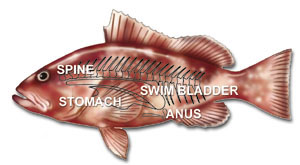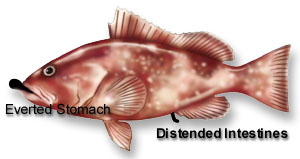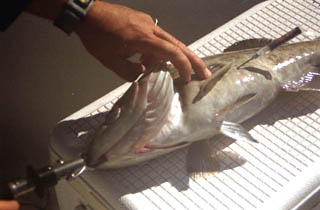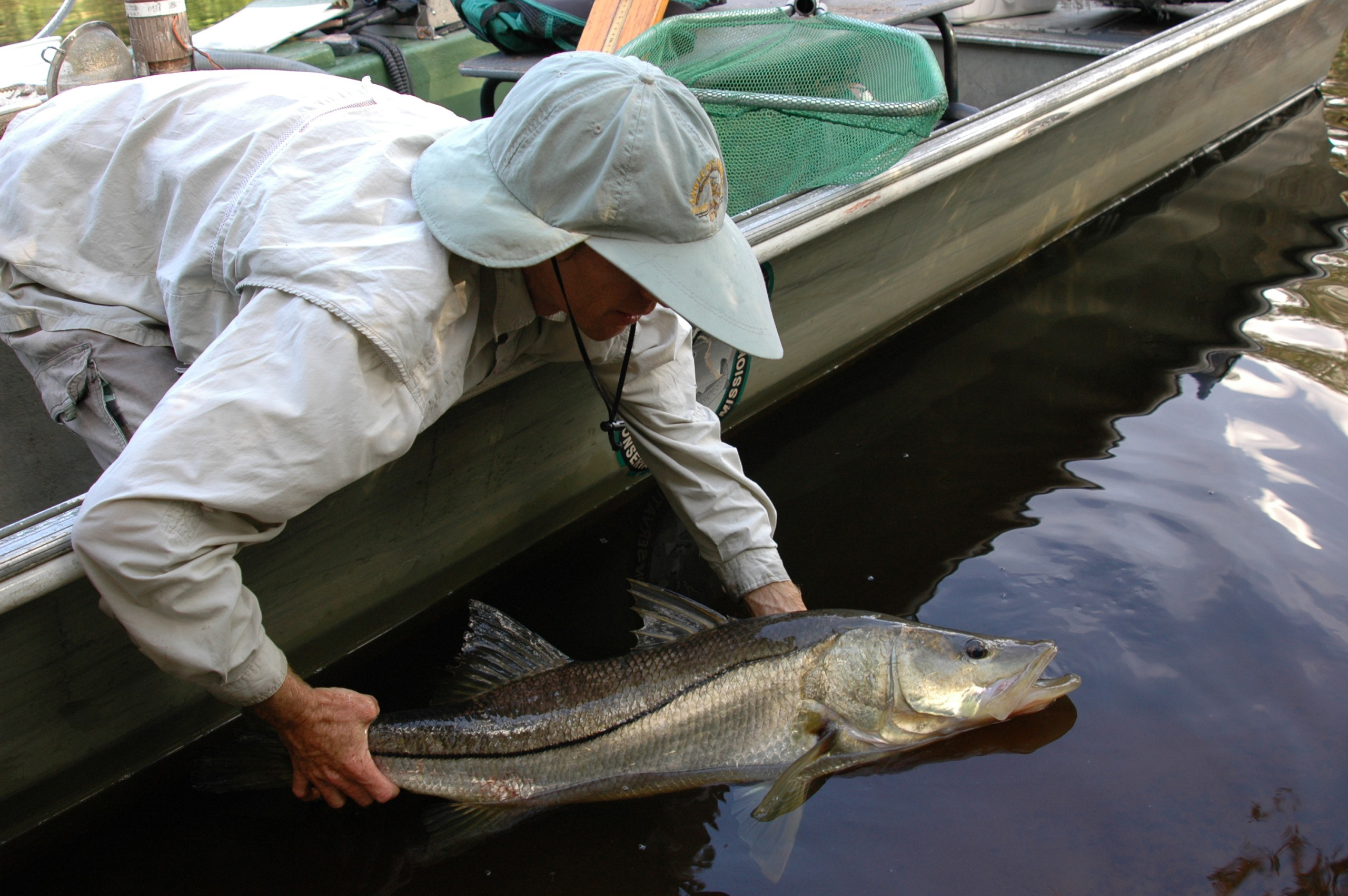The Problem
Many marine reef fish have a gas-filled organ called a swimbladder, which controls buoyancy and allows the fish to maintain a certain  depth in the water column. The gas in the swimbladder can over-expand when fish are brought quickly to the surface by hook and line. This can result in serious injury to the fish, and if released in this buoyant condition, the fish may float away and die from exposure to the elements or become an easy target for predators. This defeats the purpose of fishery management laws such as minimum size restrictions and daily bag limits.
depth in the water column. The gas in the swimbladder can over-expand when fish are brought quickly to the surface by hook and line. This can result in serious injury to the fish, and if released in this buoyant condition, the fish may float away and die from exposure to the elements or become an easy target for predators. This defeats the purpose of fishery management laws such as minimum size restrictions and daily bag limits.
SWIMBLADDER BIOLOGY
Many reef fish have a closed swimbladder, an internal organ filled with gases, mostly oxygen, carbon dioxide, and nitrogen. This organ is located in the peritoneal cavity attached to the fish’s backbone beneath the dorsal fin. Swimbladders can expand only so far before they burst. When the swimbladder bursts, the swimbladder gases escape into the fish’s body cavity, where they can continue to expand. The pressure exerted by these gases is sufficient to push the stomach out the mouth and the intestines out of the anus. Venting releases these gases from the body cavity, thus eliminating the pressure on the internal organs. If damage is not excessive, the organs will return in place on their own, once the gases are expelled. Venting also will allow the fish to overcome buoyancy problems and swim down to habitat depth, enhancing its immediate survival.
internal organs. If damage is not excessive, the organs will return in place on their own, once the gases are expelled. Venting also will allow the fish to overcome buoyancy problems and swim down to habitat depth, enhancing its immediate survival.
DETERMINING WHICH FISH TO VENT
Scientific studies have shown that species with large swimbladders such as red grouper, black sea bass, and gag derive immediate benefit from venting. Your ability to judge which fish should be vented will improve with practice and experience. After reeling in a fish, closely observe its condition. If the fish is bloated and floats (is unable to control its buoyancy) or if the fish’s stomach is distended out of the mouth, the fish should be vented. If the fish appears normal, not bloated, and is able to swim down to habitat depth on its own, venting is not necessary.
Venting Procedure
It is best to vent the fish as quickly as possible with a minimum of handling. If the fish’s stomach is everted out of the fish’s mouth, do  not attempt to push it back into the fish’s body. Expelling the swimbladder gases will allow the stomach to return to its normal position within a few hours. Hold the fish gently but firmly on its side and insert the venting tool at a 45-degree angle approximately one to two inches back from the base of the pectoral fin.
not attempt to push it back into the fish’s body. Expelling the swimbladder gases will allow the stomach to return to its normal position within a few hours. Hold the fish gently but firmly on its side and insert the venting tool at a 45-degree angle approximately one to two inches back from the base of the pectoral fin.
Only insert the tool deep enough to release the gases – do not skewer the fish. The sound of the escaping gas is audible and deflation is noticeable. If a fish is extremely bloated, use the hand holding the fish to exert gentle pressure on the fish’s abdomen to aid deflation.
Keep a good grip on the venting tool during the entire process, so that an unexpected jerk from the fish does not dislodge the tool and cause injury to others.
The fish’s everted stomach should not be punctured. This practice is not as efficient in releasing gas from the body cavity and results in additional injury.
Return the fish to the water as soon as possible. If necessary, revive it by holding the fish with the head pointed downward and moving the fish back and forth to pass water over the gills until the fish is able to swim unassisted.
These are videos where you can watch and see how it’s done.
(Short, 30-second video from Mote Marine Laboratory)
NOTE: Watching this video requires use of Real Player, a free media player for your browser. You may download the latest version at this link:http://www.real.com/realplayer.
(Report video problems to us at info@flseagrant.org)
NEW! This 2-minute video is made available by the Gulf of Mexico Fishery Management Council.
Venting Tools
A venting tool can be any hollow, sharpened instrument that allows gases to escape. Ice picks and knives are not suitable because  simply puncturing the fish is undesirable and can result in a mortal injury.
simply puncturing the fish is undesirable and can result in a mortal injury.
The Novak Venting Tool, designed and developed by Florida Sea Grant in cooperation with Mote Marine Laboratory researchers, can be purchased from Aquatic Release Conservation, Inc., (www.dehooker4ARC.com), or by calling its toll free number, 1-877-411-4272.
Venting Tools Available Today(pdf, 106k)
It is also possible to make your own venting tool. The modified hypodermic needle pictured is an excellent choice for a fish venting tool. A hollow, sharpened stainless steel cannula mounted on a hollow wooden dowel also works. Cannulas (16-gauge recommended) can often be purchased from farm supply and feed stores. The tool should be cleaned between uses and kept in a safe and accessible place. Chlorine bleach is a good disinfectant. Be sure to cap or place a cork on the tip of the tool after use to prevent personal injury.
Fish Survival Guidelines
Fishing laws are designed to maintain a desirable spawning stock size to ensure adequate future recruitment of juvenile fish. Compliance with fishing laws is essential for sustaining U.S. sport and commercial fisheries. When compliance means releasing a fish, follow these guidelines to improve its survival. 
- Have a plan for releasing a fish before landing it. Because time is crucial in keeping a released fish alive, work quickly and in concert with others on board for quick releases.
- Avoid using gaffs and landing nets if possible.
- Handle the fish as little as possible and try to keep the fish in the water.
- Handle the fish with wet hands, wet gloves or a wet towel to avoid removing the beneficial fish slime and be sure to avoid damaging the gills and eyes.
- Back hooks out using pliers or cut the leader as close to the hook as possible on throat-hooked fish. Use hooks which rapidly degrade in saltwater.
- Revive an exhausted fish in the water by passing water over the fish’s gills by using a gentle back and forth swimming motion until the fish recovers.
This research, conducted by scientists in the Fisheries Biology Program at the Center for Fisheries Enhancement, Mote Marine Laboratory, was sponsored by NOAA, Office of Sea Grant, Department of Commerce, under Grant Number NA36RG-0070.
Information on this page is based on the best available research regarding reef fish venting as interpreted by a Florida Sea Grant Advisory Panel assembled to review this research. Although the authors realize the need for further study of the influence of venting on long term reef fish survival, sufficient information exists to warrant providing guidelines to assist anglers in successful release practices.


 depth in the water column. The gas in the swimbladder can over-expand when fish are brought quickly to the surface by hook and line. This can result in serious injury to the fish, and if released in this buoyant condition, the fish may float away and die from exposure to the elements or become an easy target for predators. This defeats the purpose of fishery management laws such as minimum size restrictions and daily bag limits.
depth in the water column. The gas in the swimbladder can over-expand when fish are brought quickly to the surface by hook and line. This can result in serious injury to the fish, and if released in this buoyant condition, the fish may float away and die from exposure to the elements or become an easy target for predators. This defeats the purpose of fishery management laws such as minimum size restrictions and daily bag limits. internal organs. If damage is not excessive, the organs will return in place on their own, once the gases are expelled. Venting also will allow the fish to overcome buoyancy problems and swim down to habitat depth, enhancing its immediate survival.
internal organs. If damage is not excessive, the organs will return in place on their own, once the gases are expelled. Venting also will allow the fish to overcome buoyancy problems and swim down to habitat depth, enhancing its immediate survival. not attempt to push it back into the fish’s body. Expelling the swimbladder gases will allow the stomach to return to its normal position within a few hours. Hold the fish gently but firmly on its side and insert the venting tool at a 45-degree angle approximately one to two inches back from the base of the pectoral fin.
not attempt to push it back into the fish’s body. Expelling the swimbladder gases will allow the stomach to return to its normal position within a few hours. Hold the fish gently but firmly on its side and insert the venting tool at a 45-degree angle approximately one to two inches back from the base of the pectoral fin. simply puncturing the fish is undesirable and can result in a mortal injury.
simply puncturing the fish is undesirable and can result in a mortal injury.